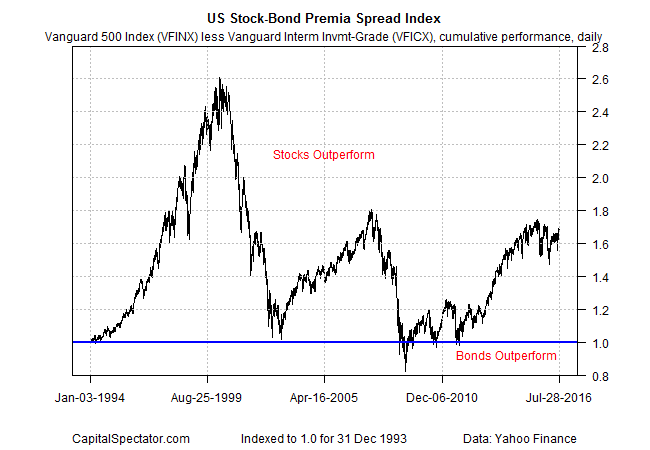The US stock market has been trading at or near record highs recently, a performance that inspires some analysts to predict that the long-running equity bull market is still poised for even greater heights. But viewed in context with the bond market, the relative return spread in favor of stocks is looking a bit tired. Is this a sign that the equity market’s recent surge is the last hurrah for the bulls? Maybe, but the relative-return edge for stocks could revive if fixed-income investing suffers because the 35-year slide in interest rates is finally poised to reverse in a meaningful degree.
Reviewing the relative performance between stocks and bonds isn’t a crystal ball by any means, but this prism offers useful perspective for chronicling the major trends in the risk-on/risk-off cycle. Let’s quantify this ebb and flow with a stock-bond return spread based on two mutual fund proxies: Vanguard {{o|S&P 500 Index}} Fund (VFINX) less Vanguard Intermediate-Term Investment-Grade Fund (VFICX), a mix of Treasuries and investment-grade US corporate bonds. The performance spread is calculated as an index of the cumulative daily return difference between the two portfolios, with a start date of Dec. 31, 1993. When the index rises, stocks are outperforming; falling values reflect stronger bond performance.

There are several interesting features in the chart above, starting with the obvious one: stocks have outperformed over the sample period, which is no surprise. Imagine the return-spread index as the basis for a fund strategy: a buy-and-hold $1 investment at the close of 1993 would be worth $1.68 at yesterday’s close (July 28). A positive return tells us (unsurprisingly) that stocks have outperformed bonds.
But note that the outperformance in favor of equities varies, and by more than trivial amounts. The peak value of the return-premium index is $2.68 in late-March 2000, which marks the end of the bull market for stocks. Soon after, a severe bear market for equities unfolds, which is accompanied by a long stretch of relative outperformance for bonds. The shift can be seen in the sharp decline in the performance spread index during that period in the chart above.
Note, too, that since the early 1990s there have been three distinct regimes when the stock market’s relative outperformance over bonds was trending up. But every investment trend has limits and the relative strength for stocks was followed by two powerful reversals, the last one unfolding from mid-2007 through March 2009. By the end of that cycle, bonds beat stocks for a brief period.
But the cycle reversed again as 2009 progressed amid the early days of economic recovery. The equity market’s relative strength has been conspicuous ever since, albeit with some rough spots along the way.
At the moment, stocks are on top once again, but the outperformance over bonds looks a bit soft relative to the two previous equity runs. In addition, the stock market’s edge over bonds has been more or less in a holding pattern for the past year. It’s unclear if this is a sign of weakness for stocks or a pause that refreshes and revives equities. Much depends on the next big move in interest rates.
It’s not unreasonable to expect that rates will trend higher in the years ahead, although it’s just as easy to imagine that yields remain in a tight and historically low range. It’s also debatable if the stock market’s post-2008 run is nearing its end—or finding its second wind.
As usual, the macro trend will dispense most of the answers to such questions. The optimistic spin is that conditions are ripe for an unusually long period of expansion, which would favor stocks and put pressure on bonds. The current expansion is the fifth-longest on record, which dates the mid-1800s, based on NBER’s data. Some analysts reason that the recovery may endure because the bounce since the last recession has been comparatively weak. As a result, a slow burn that takes longer to burn out may keep growth bubbling for an unusually lengthy stretch. If so, equity performance may be headed for a new leg up in relative terms vis-à-vis bonds—and perhaps in absolute terms as well.
The main caveat: if rates trend higher, history suggests that the Fed is in the process of taking away the proverbial punch bowl, which has a habit at some point of unleashing inverted yield curves and recessions. But the optimists have a response for this scenario too, explaining that the central bank’s policy tightening will probably be slow and gentle, thereby minimizing the business-cycle risk that often accompanies periods of rate hikes.
Meanwhile, the equity premium over bonds is intact at the moment but at a crossroads. The last several decades suggest that bull runs for equities suffer sharp, sudden reversals. But this time could be different. Are we looking at a future for an equity premium that more or less holds steady at a modest rate over bonds? That’s been reality over the past year and it’s not obvious that we’re about to see anything different in the immediate future. The question is whether the equilibrium of late has legs?
